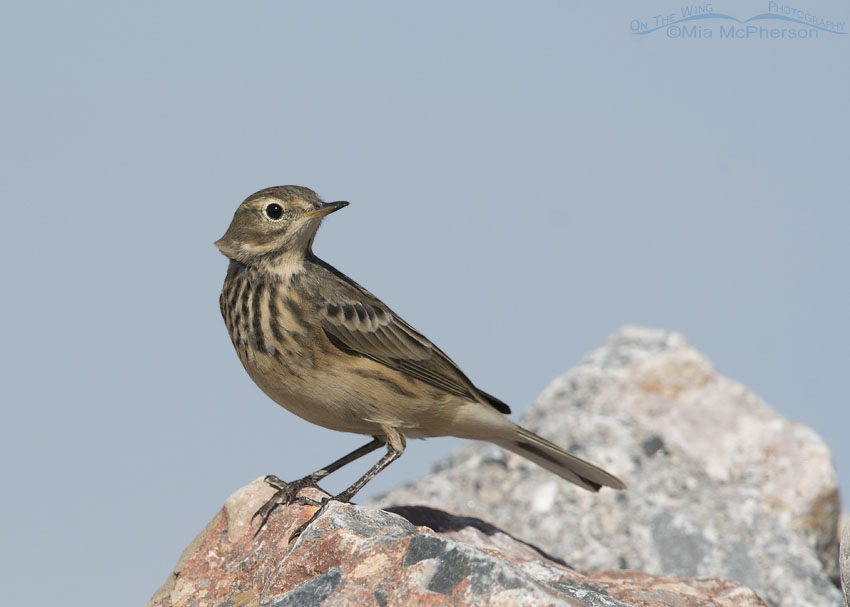 American Pipit head turn in a stiff breeze – Nikon D500, f7.1, 1/2500, ISO 320, Nikkor 500mm VR with 1.4x TC, natural light
American Pipit head turn in a stiff breeze – Nikon D500, f7.1, 1/2500, ISO 320, Nikkor 500mm VR with 1.4x TC, natural light
I’ve been hearing American Pipits on the wing for a while now and yesterday I was happy to photograph several pipits while they perched on some rocks in northern Utah. I usually hear American Pipits, Anthus rubescens, before I see them. Because of their coloring it is easy to lose sight of these birds when they are on the ground because they blend in so easily but when they perch a bit higher they are easier to see.
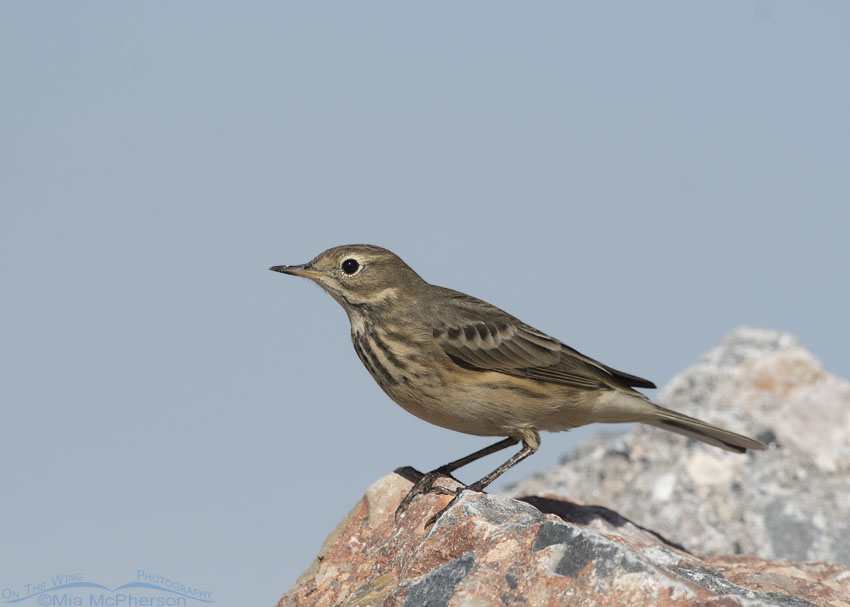 American Pipit crouching on a rock – Nikon D500, f7.1, 1/2500, ISO 320, Nikkor 500mm VR with 1.4x TC, natural light
American Pipit crouching on a rock – Nikon D500, f7.1, 1/2500, ISO 320, Nikkor 500mm VR with 1.4x TC, natural light
American Pipits prefer open country and during their breeding season can be found in alpine and arctic tundra or above the tree lines of tall mountains and during migration they prefer mudflats, plowed fields, marshes, coastal beaches and rivers. The pipits I photographed yesterday were feeding in a muddy field and when they perched on top of a pile of rocks I was able to get clear views of them.
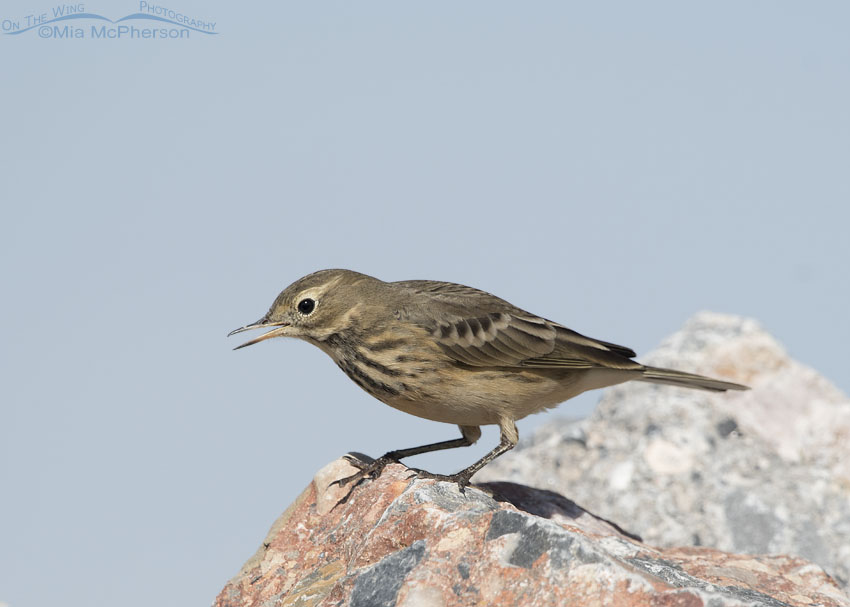 American Pipit calling while perched on a rock – Nikon D500, f7.1, 1/1600, ISO 320, +0.7 EV, Nikkor 500mm VR with 1.4x TC, natural light
American Pipit calling while perched on a rock – Nikon D500, f7.1, 1/1600, ISO 320, +0.7 EV, Nikkor 500mm VR with 1.4x TC, natural light
The pipits caught my eyes because they were flying around, chasing each other, perching on the rocks with their tails bouncing up and down and calling to each other.
American Pipits are known as Buff-bellied and Water Pipits in Europe and Asia but thier scientific name is Anthus rubescens which is the correct scientific name for our American Pipit. I just wanted to clarify that.
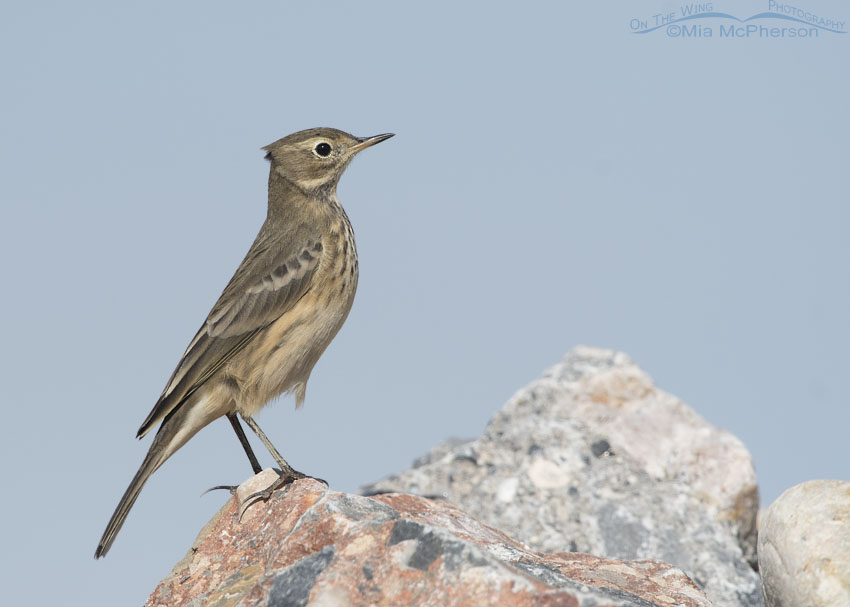 American Pipit standing tall – Nikon D500, f7.1, 1/1600, ISO 320, +0.7 EV, Nikkor 500mm VR with 1.4x TC, natural light
American Pipit standing tall – Nikon D500, f7.1, 1/1600, ISO 320, +0.7 EV, Nikkor 500mm VR with 1.4x TC, natural light
It was nice to have great, unobstructed views of the pipits on the rocks against a soft blue sky. When I took this photo the pipit seemed like it had its eye on something in the distance and was on alert. This pipit hung around long enough for me to take a nice series of images of it.
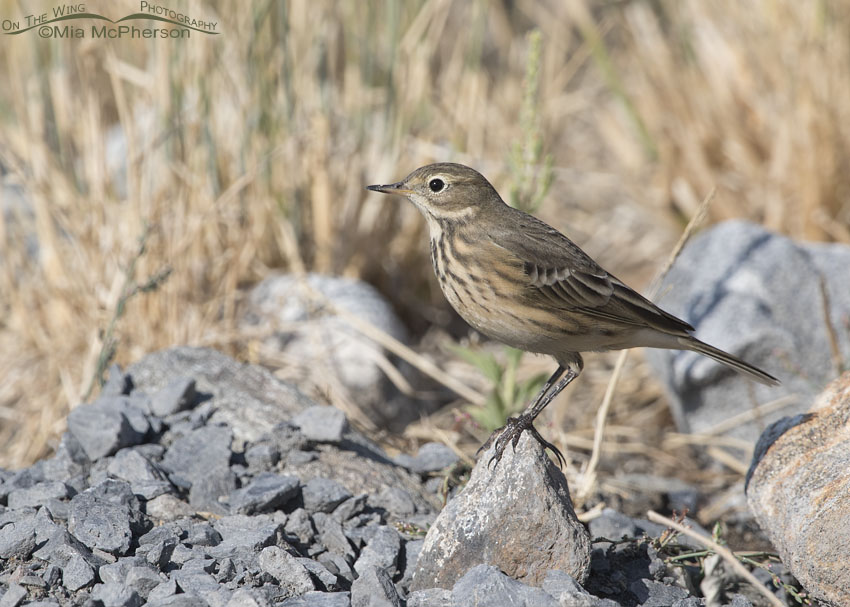 American Pipit close to the ground – Nikon D500, f7.1, 1/1250, ISO 320, Nikkor 500mm VR with 1.4x TC, natural light
American Pipit close to the ground – Nikon D500, f7.1, 1/1250, ISO 320, Nikkor 500mm VR with 1.4x TC, natural light
I had a few opportunities with the American Pipits to photograph them on the ground, in most of those photos the light angle was off and I didn’t get catch lights in their eyes but this one was close to being on the ground near a muddy field and it showed light in the eyes.
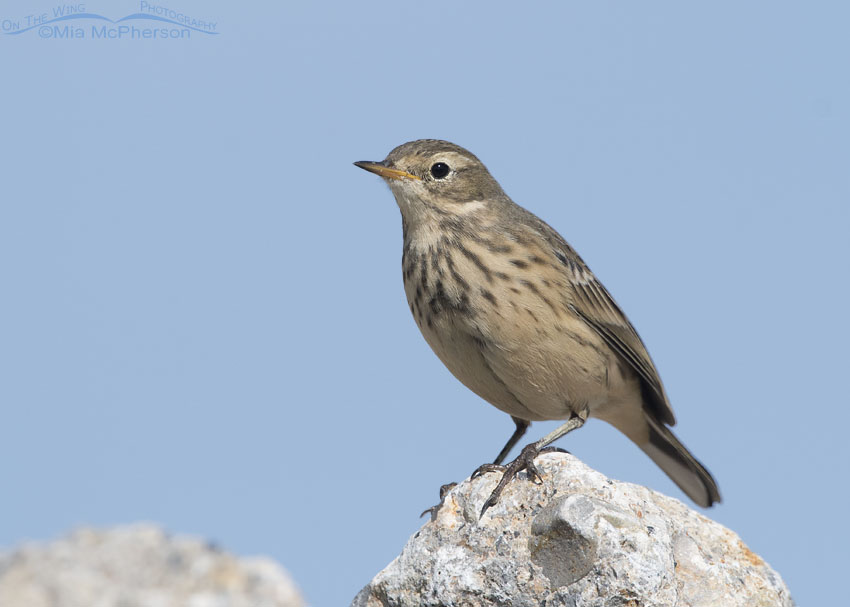 American Pipit perched on a white rock – Nikon D500, f7.1, 1/1600, ISO 320, +0.7 EV, Nikkor 500mm VR with 1.4x TC, natural light
American Pipit perched on a white rock – Nikon D500, f7.1, 1/1600, ISO 320, +0.7 EV, Nikkor 500mm VR with 1.4x TC, natural light
The pipits didn’t hang around for very long and before I knew it they took off to fly over the field calling as they went but even a few minutes with these subtle beauties is enough to delight me.
Life is good.
Mia
Click here to see more of my American Pipit photos plus facts and information about this species.


Lovely “flight call” and images too. Appearance reminds me of a Mockingbird. Don’t think I’ve seen one either.
Handsome bird and series.
What an astonishing collection of photos of Pipits, accompanied by notes both playful and scholarly. The unexpected treat was your inclusion of the recorded flight calls of the American “Buff-bellied Pipits”, joyful sounds that took me back to the years when I was able to be a field birder.
The Pipits came to me the day after my 79th birthday, another example of how much Mia McPherson (and her cohorts across the Web!) add to the quality of life of a homebound birder (MS). I echo your mantra, Mia: “Life is Good”.
Beautiful things – and a big thank you to you and Ron for also giving us their calls.
Such a pretty, sleek-looking little bird! Funny, I listened to the tape, for reason I don’t mind its tweeting at all…actually enjoyed them…unlike the tweets of the great orange ignoranus, a very strange bird indeed….
Your gentle words, Patty, make the point with delicious humour. You alert us again to a huge threat, just as “alarm tweets” from a dedicated look-out bird send all of the flock dispersing in panic. “The great orange ignoramus” you refer to is “a very strange bird indeed”, fearsome nuclear strange. Its frequent tweets are poisonous, weird and troubling, leading wise commentators to fear for the future of life itself (yes, birds also) on our beautiful blue planet. “It’s not just tax cuts, folks!!”
Thanks for sharing. I too have only seen them in a field where they were hard to photograph so it’s lovely seeing them in a different setting. They have such good camouflage that it almost looks like birds were painted with a very tiny brush as you captured the feather details. I so appreciate your sharing
I’ve never seen an American Pipit but would love to. Beautiful photos.
Mia, are they related to American Robin? Body size and markings seem to have some similarities. Nice series!
Wayne, pipits are in amongst Mockingbirds, Thrashers, Starlings, Accentors and Wagtails so not closely related to thrushes of which the American Robins belong to. American Pipits are 6.5 inches in length and 0.74 ounces whereas American Robins are 10 inches in length and weigh 2.7 ounces, it might not seem like it but pipits are smaller.
Beautiful images!